
Introduction
In the digital realm of cryptocurrencies, the name Mt. Gox evokes mixed feelings of intrigue, disappointment, and caution. Once the world’s largest Bitcoin exchange, Mt. Gox’s downfall in 2014 was a watershed moment in the cryptocurrency industry. It served as a stark reminder of the risks inherent in the still nascent world of digital currencies. This article will delve into the history of the Mt. Gox hack, unraveling the events leading up to and following one of the most significant breaches in cryptocurrency history.
The Rise of Mt. Gox
Founded in 2010 by Jed McCaleb but later run by Mark Karpeles, Mt. Gox was initially a platform for trading Magic: The Gathering cards (hence the name, Magic The Gathering Online eXchange). However, it quickly transitioned into a platform for trading Bitcoin, and by 2013, it was handling over 70% of all Bitcoin transactions globally. Its meteoric rise mirrored the growing interest in and adoption of Bitcoin.
The Fall: The 2014 Hack
Despite its popularity, Mt. Gox was plagued with security issues from the outset. In June 2011, a hacker exploited a security flaw in the exchange, driving the price of Bitcoin down to mere pennies. While Mt. Gox managed to recover from this event, it was just a precursor to the cataclysmic hack of 2014.
In February 2014, Mt. Gox halted all Bitcoin withdrawals citing technical issues. It later emerged that the exchange had been victim to a long-term hack, and it had lost about 740,000 Bitcoins (around 6% of all Bitcoins in circulation at the time). The lost Bitcoins were valued at approximately $460 million at the time and would be worth billions today.
The Aftermath
The Mt. Gox hack had far-reaching consequences. It led to a plummet in Bitcoin’s value and shook investor confidence in digital currencies. It also brought global regulatory scrutiny to cryptocurrencies, leading to calls for better security measures and regulation in the industry.

In the years following the hack, investigations revealed that the breach was possible due to lax security practices and possible internal malfeasance. Mark Karpeles was arrested by Japanese authorities and charged with embezzlement and data manipulation, though he was later acquitted of the embezzlement charges.
Lessons from the Mt. Gox Saga
The Mt. Gox saga is a cautionary tale in the cryptocurrency industry. It underscores the importance of robust security protocols in digital asset exchanges. The incident has led to significant improvements in security practices among cryptocurrency exchanges and a push towards more transparency and regulation.
Moreover, it served as a reminder to investors about the risk associated with digital currencies and the importance of keeping their digital assets secure.
Conclusion
The Mt. Gox hack remains one of the most infamous events in cryptocurrency history. It serves as both a symbol of Bitcoin’s early volatility and a lesson in the importance of security in the cryptocurrency arena. As we continue to navigate the evolving landscape of digital currencies, the tale of Mt. Gox continues to serve as a sobering reminder of the potential risks and rewards that lie within the world of cryptocurrencies.
References:






